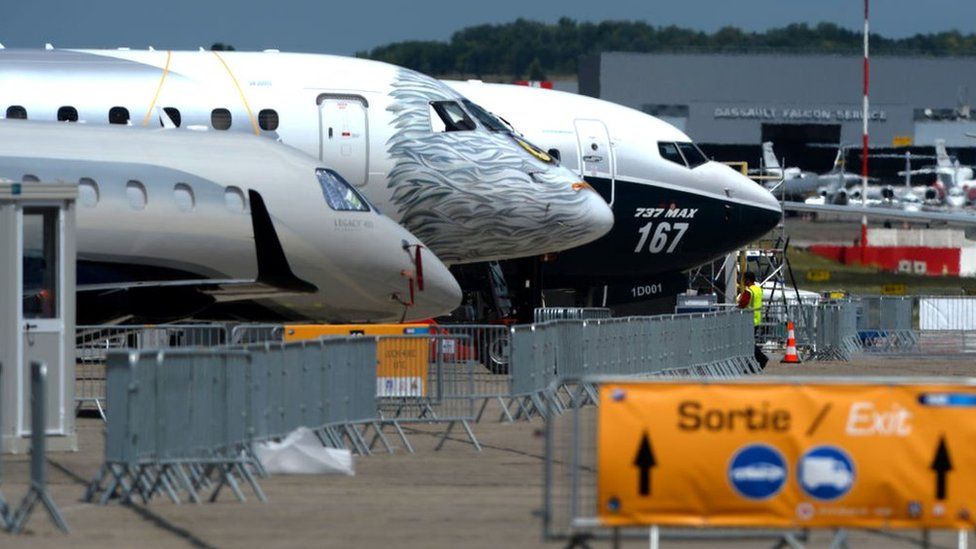Paris Airshow: Boeing and Airbus under pressure
- Published

The Paris airport of Le Bourget was once a pretty glamorous place. It was here that aviation pioneer Charles Lindbergh landed after his solo flight across the Atlantic in 1927, and it was a gateway to the French capital for Hollywood legends such as Audrey Hepburn for many years.
Those days are long gone.
Surrounded by drab suburbs and urban motorways it now caters mainly for private jets, whose passengers spend as little time as possible amid its rather bleak and windswept surroundings - although it does have a rather good aviation museum.
But for the next week Le Bourget will become the beating heart of the global aerospace industry.
Scores of politicians - including newly elected President Macron - generals and chief executives will be among the hundreds of thousands of visitors, braving horrendous traffic and negotiating tight security to attend the 52nd Paris Air Show.
So what will be the main talking points in the plush chalets and teeming exhibition halls this year?
Traditionally, the headlines are dominated by big order announcements from home favourite Airbus and the US aerospace giant Boeing, but the market is far less frothy than it used to be.
Global aircraft orders have declined by about half since their peak in 2014. Low oil prices mean that airlines are under less pressure to replace old aircraft with newer, more efficient models.
So we may see fewer announcements.
That isn't a huge problem in itself - both manufacturers already have bulging order books, and both have struggled with supply chain problems, causing delays on the production line. So a reduction in demand may be no bad thing.
However that doesn't apply across the board. The giant A380 superjumbo is the flagship of the Airbus fleet - and its appearance is usually a highlight of the air display. But it isn't selling well and last year the company halved its annual production.
It would doubtless love to announce further orders in Paris but that seems very unlikely. In fact, some are questioning whether the aircraft has a future at all.
In the circumstances, Airbus could well find itself upstaged by its American rival. Boeing is expected to set out details of a planned new mid-sized aircraft, a super-efficient model which will sit between the largest 737 and the smallest 787 in its range.
Meanwhile the latest in a series of heavily upgraded 737 models - the Max 10 - is likely to be formally launched at the show.
Yet the two established giants could be forgiven for looking nervously over their shoulders.
China's Comac and Russia's Irkut have both begun testing new airliners over the past few weeks. Neither the C-919 nor the MC-21 will be at the show - but they will certainly be talked about. The market for smaller jets is about to become a lot more crowded.
While most of the actual business at Le Bourget is done in the chalets and exhibition halls, the flying display allows companies to show off their latest multi-billion dollar technology.
Among the highlights this year will be the F-35 Lightning II, also known as the Joint Strike Fighter.
It is the product of the world's most expensive defence programme, an international effort led by the US contractor Lockheed Martin - and one which has been beset by delays and cost overruns. It badly needs some good PR, so it can be expected to put on a spectacular show.
Elsewhere, much of the talk will focus on new technology.
Outwardly, aircraft may have changed little over the past few decades. But the way in which they are designed, built, maintained and operated has been transformed. That trend is likely to accelerate.
Many of the exhibitors will be showing how virtual reality, augmented reality and 3D printing are already having a major impact on different parts of the industry - and suggesting how their potential could be exploited even further.
For some the future lies in Big Data; analysing huge reams of information to detect patterns, create models and to predict future performance.
"The amount of data this industry generates is massive and growing," says John Schmidt, managing director of Accenture's aerospace and defence business.
"A single flight by a Boeing 787 generates enough data to fill about 200 DVDs", he says. "But very little of that data is actually used."
Big data, he thinks, can transform the way aerospace companies operate.
The organisers of the show, Gifas, are also keen to show off their futuristic credentials. For that reason, they have set up an "Air Lab" dedicated to new technology and ideas, from both established companies and start-ups.
With a rather nice touch, they've put it inside Le Bourget's Concorde Hall - an area dominated by two models of the supersonic airliner that was once ahead of its time, is now obsolete, but still manages to look outrageously futuristic.